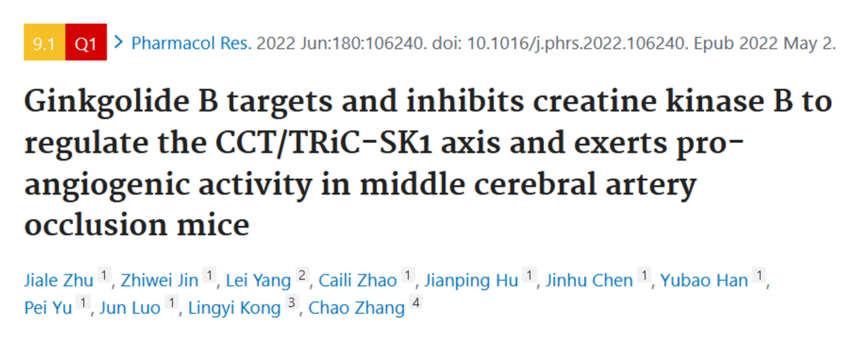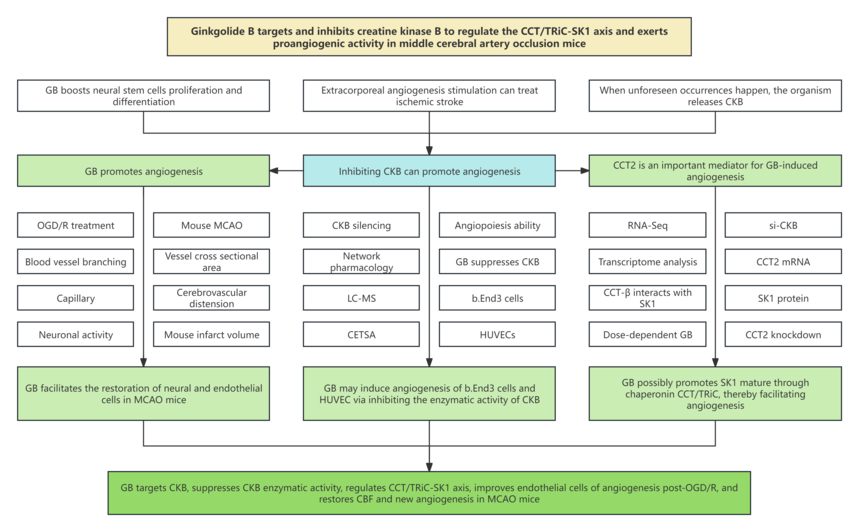Please click the button below to go to our email login page
|
IF of 9.1! A New Frontier in “Angiogenesis + Stroke”! Lingyi Kong/Chao Zhang’s Team from China Pharmaceutical University Proposes A New Direction in Stroke TreatmentAngiogenesis, also known as new blood vessels formation, refers to a biological process that new blood vessels form from existing blood vessels, which plays a key role in tissue repair and growth as well as pathological changes in some diseases including cancer. Then, what are the design ideas for research topics on angiogenesis? Let’s explore them together today.
Today, we will share a paper published on Pharmacological Research, with IF of 9.1, hoping to bring different inspirations.
1. Research background 1.1 Many patients suffer from stroke due to cerebrovascular narrowing and occlusion that limit the flow of blood to brain tissues and cause tissue hypoxia, ischemia and necrosis, ultimately leading to brain dysfunction; 1.2 rt-PA is the only thrombolytic drug for acute ischemic stroke approved by FDA, but should be taken within 6 hours after stroke and may increase the risk of developing hemorrhagic stroke; 1.3 In the acute stage of ischemic stroke, the organism’s own circulatory compensation system may be insufficient to maintain sufficient energy supply. Extracorporeal angiogenesis stimulation is an important treatment method for ischemic stroke; 1.4 Ginkgolides B (GB) can promote neural stem cell proliferation and differentiation and mediate microglia cell polarization; 1.5 When unexpected events occur (such as ischemic stroke, cerebral vascular rupture, etc.), the organism automatically releases a large amount of creatine kinase B (CKB), promoting the synthesis of substantial ATP and ensuring energy supply.
2. Technical route
3. Research results 3.1 Inhibiting CKB boosts angiogenesis. 3.2 Network pharmacology analysis and dart analysis revealed GB interacts with CKB protein. 3.3 GB enhances angiogenesis of b.End3 cells and HUVEC. 3.4 GB exerts angiogenesis-promoting effects in vivo and in vitro after OGD/R and ischemic stroke. 3.5 GB mitigates neural function in MCAO mice and reduces cerebral infarction. 3.6 CCT2 is a vital mediator in GB-induced angiogenesis. 3.7 GB upregulates CCT/TRiC-SK1 axis to enhance angiogenesis. 4. Research conclusion This study aims to clarify pharmacodynamic effects and underlying mechanism of GB on post-stroke angiogenesis. Initially, GB apparently elevates proliferation, migration and angiogenesis of b.End3 cells and HUVEC. Additionally, GB significantly alleviates the angiogenesis of endothelial cells after OGD/R. Through observation of cerebral hemodynamics, cerebral microvascular neovascularization and reconstruction, and cerebral endothelial tissue integrity in MCAO mice, as well as unlabeled target detection technology, they discovered for the first time that GB can specifically target CKB and inhibit its enzymatic activity. Also, they, through network pharmacology and a series of molecular biology experiments, proves GB dampens CKB, and promotes angiogenesis via CCT/TRiC-SK1 axis. These discoveries provide new ideas for novel treatment strategies, where GB is applied to treat neural recovery and endothelial repair after ischemic stroke. |


